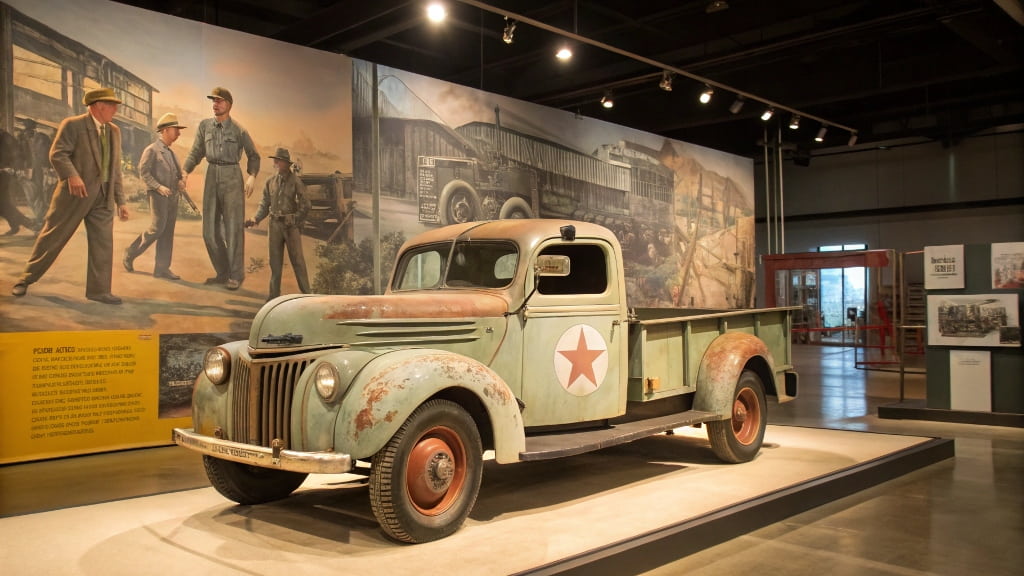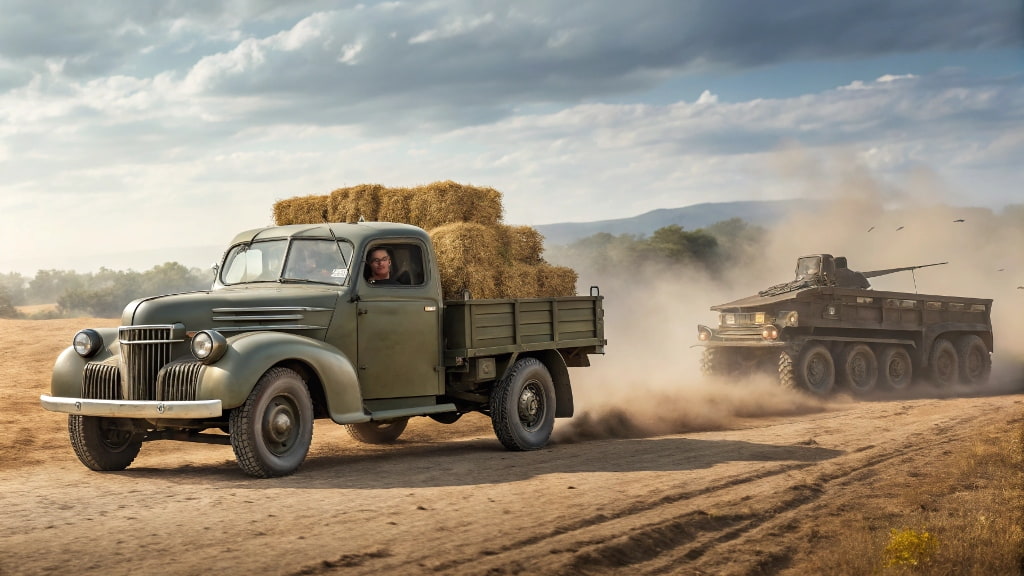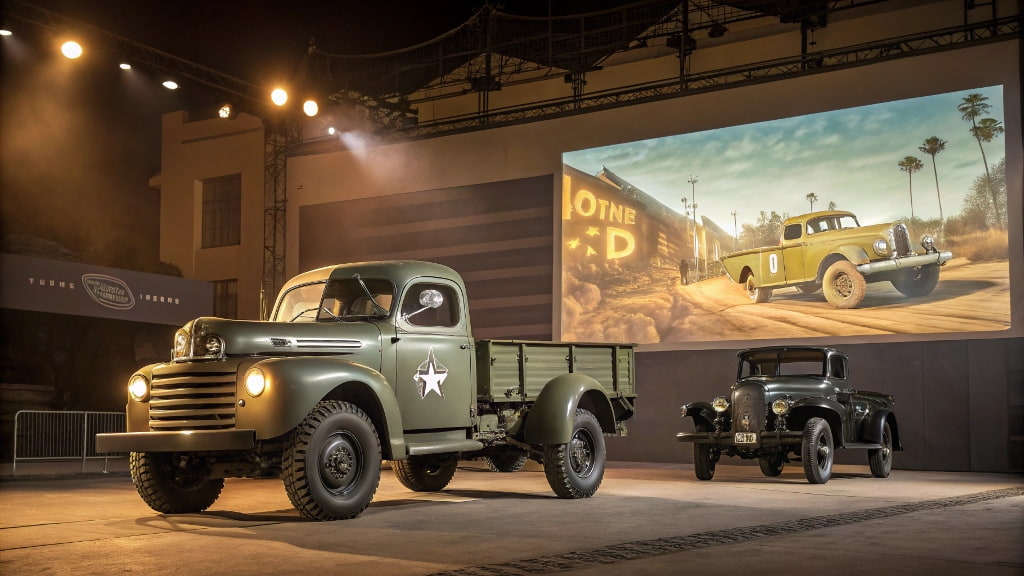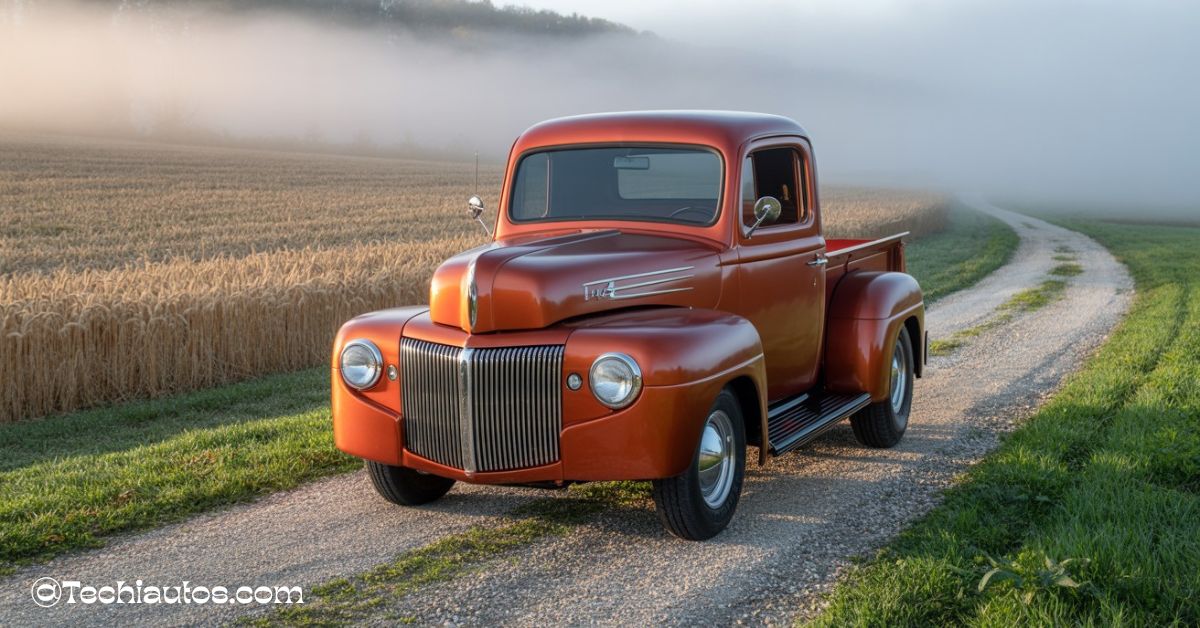The 1942 Ford truck is a classic American pickup renowned for its rugged design and robust build, produced just before the onset of World War II. It marked a key moment in Ford’s history with updated styling and mechanics, making it highly valued by collectors today. This truck’s legacy lives on as the foundation of the iconic Ford F-Series lineup.
Stay tuned with us! We will soon delve deeper and discuss the 1942 Ford truck, exploring its history, design, and what makes it a beloved classic today.
Introduction: What is the 1942 Ford Truck?
The 1942 Ford truck is a classic pickup that holds a special place in American automotive history. Built just before World War II, this truck was one of the last civilian vehicles made before Ford shifted its focus to military production. Even today, people respect the 1942 Ford truck for its rugged build, simple design, and strong engine.
This truck marked a turning point for Ford. It introduced new styling, improved suspension, and under-the-hood updates. The body had a bold, clean look, with a wide grille and smooth fenders. Inside, it kept things basic—strong materials, a simple dash, and practical controls.
Because Ford stopped making civilian trucks shortly after early 1942, the 1942 Ford truck became rare. That makes it even more valuable to collectors and fans. Many people still search for these models, whether to restore them or simply admire their design and strength.
In short, the 1942 Ford truck stands as a symbol of pre-war American craftsmanship, with a story that continues to interest car enthusiasts today.
Wartime History & Production Suspension

The 1942 Ford truck was produced during a period of significant transformation. In early 1942, the U.S. joined World War II, and everything shifted, including vehicle production. Ford had to stop making trucks for regular buyers and focus on building machines for the war.
The government told car companies to pause civilian production. As a result, the 1942 Ford truck became one of the last trucks sold to the public before the outbreak of the war. On February 10, 1942, Ford officially ceased production of civilian trucks. After that, the company primarily built military vehicles, including tanks, jeeps, and transport trucks.
This pause made the 1942 Ford truck rare. Only a limited number were made before the shutdown. That’s why collectors value it today—not just for its style and build, but for the unique moment in history it represents.
The 1942 Ford truck is more than a vehicle. It’s a symbol of how the auto industry contributed during wartime, and why this model remains significant decades later.
Design & Styling – Then and Now
The 1942 Ford truck featured a bold new look that distinguished it from earlier models. Ford gave it a broad, strong front grille with horizontal bars and smooth, rounded fenders. The hood was more rectangular, and the headlights were integrated into the fenders, giving it a clean and solid front end. It looked tough and ready for work, which made it popular with farmers and small businesses.
Inside, the 1942 Ford truck kept things simple. The dashboard was made of metal, painted to match the exterior. It had easy-to-read gauges and a large steering wheel. The seat was firm but made to last. There weren’t many extras—just what drivers needed to get the job done.
Today, the design of the 1942 Ford truck is seen as classic. Collectors and restorers love the original shape and style. Some choose to keep it all original, while others add modern touches, such as new paint or custom wheels. Either way, the truck’s vintage charm stays strong.
From its bold front end to its no-frills interior, the 1942 Ford truck blends history with lasting design. It still turns heads and shows how innovative styling can stand the test of time.
Chassis & Mechanical Innovations
The 1942 Ford truck introduced essential changes under the body. Ford improved the frame and suspension to make the car firmer and smoother to drive. One of the most significant updates was the introduction of a new ladder-type chassis, replacing the older design. This provided the truck with better support and made it more durable for handling heavy loads.
The suspension also changed. Ford moved away from the older transverse leaf springs and replaced them with semi-elliptic leaf springs on all four wheels. This modification helped the 1942 Ford truck handle bumps more effectively and provided drivers with a more stable ride, even on rough roads.
Another update was the Hotchkiss drive system, which replaced the older torque tube setup. This made the rear axle more reliable and easier to repair. Ford also ensured the truck had strong axles and improved brakes to match the new frame and suspension.
These updates made the 1942 Ford truck more than just good-looking. It became a workhorse that could carry heavy loads and handle tough jobs with ease. Even today, people who restore these trucks respect the smart changes Ford made to the chassis and mechanics.
Engine Lineup & Performance Overview
The 1942 Ford truck came with solid engine choices that gave it the power and reliability drivers needed. The most common option was the flathead V8 engine, a 221-cubic-inch motor that produced around 90 horsepower. This engine was well-known for being tough, simple, and easy to repair—perfect for work on farms, job sites, and back roads.
Some models of the 1942 Ford truck also came equipped with an inline 6-cylinder engine, which provided a smoother ride and improved fuel economy. A smaller 4-cylinder engine was also available in some light-duty models, offering good fuel economy for basic hauling tasks.
When it came to performance, the 1942 Ford truck was built more for strength than speed. Its top speed was around 60–65 mph, which was fine for the roads of that time. The fuel tank held approximately 15 gallons, providing a driving range of around 190 miles, depending on the engine and load.
These engine options provided buyers with the flexibility to select a setup that best suited their needs. Whether hauling tools, crops, or goods, the 1942 Ford truck had enough power to get the job done without fuss. Even today, its engines are praised for their simple design and lasting quality.
Military vs Civilian 1942 Ford Trucks
The 1942 Ford truck came in two main types: civilian and military. Both shared many parts but served very different purposes during a critical time in history.
The civilian 1942 Ford truck was built for everyday use. Farmers, small businesses, and delivery drivers relied on it for hauling and transportation. These trucks featured a classic, bold grille, simple interiors, and engine options, such as the flathead V8. However, civilian production stopped on February 10, 1942, as Ford shifted focus to the war effort.
Military versions of the 1942 Ford truck were designed to meet more challenging demands. Known as the 21C model, these trucks featured heavy-duty parts, reinforced frames, and notable military characteristics, including blackout lights and rugged tires. They were used by the Army and other branches for transport, supply, and support tasks.
While civilian 1942 Ford trucks focused on comfort and practicality, military trucks prioritized durability and versatility above all else. Collectors now prize both versions, but the military models are rarer due to their specialized use and limited production during wartime.
Overall, the difference between military and civilian 1942 Ford trucks shows how the same basic design was adapted to meet both everyday and critical wartime needs.
Real World Use: On the Farm and Base

The 1942 Ford truck was a hardworking vehicle both on farms and on military bases. For farmers, this truck was a reliable tool. It helped carry crops, feed, and equipment across fields and dirt roads. Its strong frame and simple mechanics made repairs easy, which was important when working far from a mechanic.
On military bases, the 1942 Ford truck served in a variety of roles. It moved supplies, tools, and personnel around large installations. Trucks like the 21C model were built tougher to handle heavy loads and rough terrain. Some even got special modifications, such as flatbeds or dump beds, to fit different tasks.
Both on farms and bases, the 1942 Ford truck proved itself dependable and versatile. It could carry heavy loads, navigate rough terrain, and continue operating day after day. This real-world toughness helped build the truck’s reputation and lasting legacy among drivers and collectors today.
Restoration Challenges & Collector Appeal
Restoring a 1942 Ford truck can be a rewarding experience, but it also presents challenges. Because this truck was manufactured over 80 years ago and had a limited production run before wartime interruptions, finding original parts can be challenging. Some parts are rare or expensive, especially engine components and body panels. Restorers must be patient and resourceful, sometimes turning to specialized suppliers or salvage yards.
Despite these challenges, the 1942 Ford truck is highly prized by collectors. Its historic value, classic design, and role in wartime production make it a standout. Restored trucks often attract attention at shows and auctions, where prices can range from moderate to high, depending on condition and originality.
Collectors appreciate the 1942 Ford truck for its straightforward mechanics, making restoration accessible to those with basic skills. Its timeless look and sturdy build also mean these trucks can be enjoyed as daily drivers or showpieces. This combination of challenge and appeal keeps the 1942 Ford truck a favourite among vintage truck enthusiasts.
Legacy: Foundations of the F-Series Truck Line
The 1942 Ford truck laid the groundwork for what would become one of America’s most famous truck families — the Ford F-Series. Its strong frame, rugged design, and reliable engines set new standards for pickup trucks. After World War II, Ford took many lessons from the 1942 Ford truck and used them to create the first F-Series in 1948.
This truck’s ladder-frame chassis and improved suspension became key parts of later Ford pickups. The 1942 Ford truck showed how to build a tough, work-ready truck that could also appeal to everyday drivers. As a result, it holds a significant place in the history of Ford trucks and the evolution of modern pickups.
Fun Facts, Rare Variants & Pop Culture Appearances

The 1942 Ford truck has some incredible stories and surprises. For example, a rare variant called the “2N” reportedly used a tractor engine, making it unique and highly collectible. Some military models featured special features, such as blackout lights, for nighttime operations.
This truck has appeared in several classic films and vintage TV shows, often representing the World War II era or rural America. Its distinct look makes it a popular choice for period movies and car shows.
Collectors and fans love to share stories about discovering hidden gems, such as panel trucks or dump-bed conversions. These fun facts enhance the charm and mystery of the 1942 Ford truck, keeping interest alive among enthusiasts worldwide.
Market Values & How to Price Yours
The 1942 Ford truck is a rare and valuable classic vehicle. Its limited production before wartime shutdown makes it sought after by collectors. Prices vary widely based on condition, originality, and model type. Well-restored trucks can sell anywhere from $20,000 to $50,000 or more. Trucks in fair or unrestored condition may be priced lower, but still hold good value due to their historical importance.
When pricing your 1942 Ford truck, consider factors such as engine originality, body condition, and the level of completeness of the car. Trucks with original parts and minimal rust tend to fetch higher prices. Market trends can change, so it’s good to check recent sales on classic car sites or consult valuation guides like Hagerty.
FAQ’s
1. How much is a 1942 Ford worth?
A 1942 Ford truck can be worth between $20,000 and $ 50,000, depending on its condition and originality.
2. How many 1942 Fords were made?
Ford produced approximately 77,000 civilian trucks before stopping production in early 1942 due to the war.
3. How much is a 1942 Ford GPW?
A 1942 Ford GPW (military Jeep) typically sells for around $30,000 to $60,000, depending on condition and restoration.
4. How much is a 1940 Ford pickup worth?
A 1940 Ford pickup typically ranges from $15,000 to $ 40,000 or more, depending on its condition and originality.
Conclusion: Lasting Importance of the 1942 Ford Truck
The 1942 Ford truck remains a symbol of American strength and resilience. Built during a time of significant change, it blends rugged design with historical significance. Its role in both civilian life and wartime efforts makes it more than just a truck — it’s a piece of history.
For collectors and enthusiasts, the 1942 Ford truck presents an opportunity to own a vehicle that played a pivotal role in shaping modern pickups. Its legacy lives on through the Ford F-Series and the many restored models still on the road today. Whether on a farm, a military base, or at a car show, the 1942 Ford truck stands as a timeless example of quality and durability.
Also read:
- 1970 Ford Galaxie Sedan: Classic American Cruiser
- Best 1997 Ford Ranger Transmission Fluid Guide
- 1936 Ford Coupe for Sale: Classic Deals Near You & in Texas!
